Douglas Albert Munro | |
|---|---|
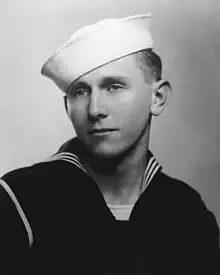 | |
| Nickname(s) | "The Gold Dust Twins" (with Ray Evans) |
| Born | October 11, 1919 Vancouver, British Columbia, Canada |
| Died | September 27, 1942 (aged 22) Matanikau River, Guadalcanal, Solomon Islands |
| Buried | Laurel Hill Memorial Park, Cle Elum, Washington, United States |
| Allegiance | United States |
| Service/ | United States Coast Guard |
| Years of service | 1939–1942 |
| Rank | Signalman First Class |
| Service number | 217–739[1] |
| Battles/wars | World War II |
| Awards | Medal of Honor Purple Heart |
| Memorials | Douglas Munro Memorial (Honiara, Solomon Islands) Douglas Munro Memorial (Crystal River, Florida) Douglas Munro Burial Site (Cle Elum, Washington) Douglas Munro statue (Cape May, New Jersey) Douglas Munro bust (Washington, D.C.) |
| Relations | Edith Munro (mother) Francis Fairey (uncle) |
Douglas Albert Munro (October 11, 1919 – September 27, 1942) was a United States Coast Guardsman who was posthumously decorated with the Medal of Honor for an act of "extraordinary heroism" during World War II. He is the only person to have received the medal for actions performed during service in the Coast Guard.[lower-alpha 1]
Munro was born in Canada to an American father and a British mother, and his family moved to the United States when he was a child. He was raised in South Cle Elum, Washington, and attended Central Washington College of Education before volunteering for military service shortly before the United States entered World War II. Munro and his shipmate Raymond Evans were known as the Gold Dust Twins, so-called because they were inseparable.[3]
During the Guadalcanal Campaign, Munro was assigned to Naval Operating Base Cactus at Lunga Point, where small boat operations were coordinated. At the Second Battle of the Matanikau in September 1942, he led the extrication of a force of Marines whose position had been overrun by Japanese forces. He died of a gunshot wound at age 22 while using the Higgins boat that he was piloting to shield a landing craft filled with Marines from Japanese fire.
Several ships, buildings, and monuments have been dedicated to Munro, and a street in his hometown is named after him. The anniversary of his death is annually observed in Cle Elum and at Coast Guard Training Center Cape May. His grave has been designated a historical site by Washington state. He is the namesake of the Douglas A. Munro Coast Guard Headquarters Building, Munro Hall at the U.S. Coast Guard Academy,[4] the "Douglas Munro March", the Navy League's Douglas A. Munro Award, the Coast Guard Foundation's Douglas Munro Scholarship Fund, and the Veterans of Foreign Wars' Douglas Munro–Robert H. Brooks Post. He is the only non-Marine to have his name enshrined on the Wall of Heroes of the National Museum of the Marine Corps.
Early life and education
Family
Munro's father, James Munro (1891–1962), was born in Sacramento, California as James Wilkins. By age eight he had moved to Canada; his divorced mother remarried a Canadian citizen whose surname he took.[lower-alpha 2] Munro's mother, Edith Fairey (1895–1983), was born in Liverpool, England, and—in childhood—relocated with her family to Canada.[6]: 6–7 [lower-alpha 3] James Munro and Fairey married in 1914 at Vancouver's Christ Church Cathedral; under U.S. naturalization laws at the time, Fairey automatically assumed American citizenship upon her marriage to Munro.[6]: 6
Youth, schooling, and enlistment
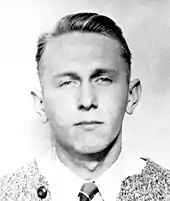
Douglas Albert Munro was born on October 11, 1919, in Vancouver, British Columbia. His father repatriated his family from Canada to the United States in 1922, settling in South Cle Elum, Washington, where he was employed as an electrician.[5]: 2 Munro was baptized at the Holy Nativity Episcopal Church in South Cle Elum.[6]: 6
In his youth Munro showed a high level of musical aptitude, mastering percussion, trumpet, and harmonica. He performed in a drum and bugle corps sponsored by the American Legion, the Sons of the American Legion Drum and Bugle Corps, eventually becoming the corps' drillmaster. Munro was also a member of Cle Elum's Boy Scout Troop 84. He attended Cle Elum High School, where he was a member of the school's wrestling team.[6]: 8, 16 Following his 1937 high school graduation, Munro enrolled in the Central Washington College of Education due to its proximity to Cle Elum, so that he could continue performing in the Sons of the American Legion.[5]: 2 Munro was a yell king (a male cheerleader) at Central Washington.[6]: 10 [12]
In 1939, with the threat of war growing, Munro decided to withdraw from college and enlist in the military.[6]: 15 He reportedly told his sister he had chosen the Coast Guard because its primary mission was saving lives. Slightly built, Munro spent the week before his induction eating heavily to meet the Coast Guard's minimum weight standard.[5]: 2, 3 He spent most of his last night in Cle Elum with his friend Marion "Mike" Cooley, with whom, according to Munro's biographer, Gary Williams, he had been "almost inseparable" since childhood.[6]: 16
Munro underwent entrance processing in Seattle, where he met and became friends with Ray Evans.[13] Munro would spend the rest of his Coast Guard career with Evans, and the pair became known to shipmates as "the Gold Dust Twins".[14][lower-alpha 4]
Career

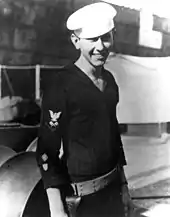
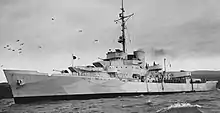
Munro and Evans underwent recruit training at Coast Guard Air Station Port Angeles. They were then assigned to the Treasury-class cutter USCGC Spencer, serving aboard the vessel until 1941.[13] During the course of his military service, Munro received consistently high marks on his performance evaluations and—according to Evans—expressed a desire to become a career Coast Guardsman.[6]: 30 [10]
Guadalcanal campaign
In mid-1941, with tension with Japan on the rise, the U.S. government began emergency mobilization, and transferred the Coast Guard from the Department of the Treasury to the Department of the Navy. Munro and Evans volunteered for reassignment to the attack transport USS Hunter Liggett, which was being outfitted and manned by the Coast Guard as part of preparations for War Plan Orange.[13][16]: 323–24 [17][18]
By mid-1942, Hunter Liggett had been assigned to Transport Division 17, tasked with supporting the Guadalcanal Campaign.[6]: 41 In preparation for the planned amphibious operations, Navy personnel began training as small boat handlers under Coast Guard tutelage; owing to the shortage of coxswains, Munro and Evans volunteered to join the training.[6]: 78 Prior to the initial landings at the Battle of Tulagi and Gavutu–Tanambogo, Munro was posted to Rear Admiral Richmond Kelly Turner's staff aboard USS McCawley.[19]: 14 Cross-trained as both a coxswain and a signalman, he was ordered to ferry troops to shore during the third attack wave, then beach his boat and attach himself to a U.S. Marine unit to help manage ship-to-shore communication.[6]: 95–96
Following the Allied victory at Tulagi and Gavutu–Tanambogo, Munro and Evans were among Coast Guard and Navy personnel who staffed Naval Operating Base (NOB) Cactus at Lunga Point on the northern coast of Guadalcanal. NOB Cactus served as a communication hub between land forces and offshore vessels.[19]: 14 [20] Established on August 9 by Coast Guard Commander Dwight Dexter, NOB Cactus is the only known instance of a naval operating base primarily led by Coast Guard personnel.[21] Munro volunteered for assignment at Lunga Point; Dexter was his favorite officer.[22]
According to U.S. Marine Master Sergeant James Hurlbut, Munro and Evans lived at the base in an approximately 80-square-foot (7.4 m2) hut "they had made from packing boxes and scrap material", which he also described as "quite a swank establishment for Guadalcanal".[23]
On September 20, 1942, Munro volunteered to lead a small boat search-and-rescue mission seeking to recover the crew of a Navy airplane that had been forced down off Savo Island. During the operation, Munro's craft came under intense fire from Japanese shore positions, though he was able to maneuver the boat back to base with only minor injuries to his crew. The downed aircrew was ultimately found and rescued by a flying boat.[6]: 42
On September 27, Lt. Colonel Chesty Puller ordered three companies of Marines to attack the flank of Japanese positions on the west side of the Matanikau River. Munro was placed in charge of two landing craft tank (LCT) and eight Higgins boats tasked with transporting the Marines to their landing points.[5]: 4 Preceded by a beach-clearing ship-to-shore bombardment from the destroyer USS Monssen, the amphibious force landed and began moving inland towards its objective.[6]: 47 Meanwhile, Munro withdrew his boats to Lunga Point as ordered, carrying with him injured sailors and Marines, among them Navy coxswain Samuel B. Roberts, who had been mortally wounded while using his landing craft to draw Japanese fire away from the Marines.[5]: 4 [24]
The U.S. Marine Corps landing force came under attack in a Japanese counteroffensive and quickly found itself encircled on a hill. With the Marines in danger of being overrun, Monssen opened fire on the Japanese positions with her 5-inch (127 mm) caliber guns, managing to clear a narrow corridor to the beach. Using Monssen's signal lamp, Puller ordered the Marines to fight their way to the shore.[25]
At Lunga Point, the landing craft were instructed to return and extract the besieged Marines.[24] Commander Dexter asked Munro and Evans if they would take charge of the mission, to which Munro answered, "Hell yes!"[5]: 4 [24] As the boats under Munro's charge approached the recovery points, they came under heavy fire from the Japanese at a ridge abandoned by the Marines. Munro used a .30 caliber machine gun aboard his landing craft to direct suppressing fire against the enemy positions as the other boats recovered the Marines. With Japanese troops moving against the beach, Munro piloted his boat closer to shore to act as a shield. Though the initial extraction was successful, one of the LCTs became grounded on a sandbar. Munro directed the other LCT to help extricate the grounded vessel as he maneuvered his own boat to shield the Marines from Japanese fire from the shore. Munro was shot in the base of his skull and lost consciousness.[5]: 4
The LCT was ultimately freed and the boats resumed their withdrawal. When out of range of Japanese forces, Munro briefly regained consciousness before succumbing to his wounds. According to Evans, his dying words were, "Did they get off?"[5]: 4–5 [10] Evans said later that "... seeing my affirmative nod, he smiled with that smile I knew and liked so well, and then he was gone".[24]
Burial and decoration

Munro was buried on September 28, 1942, the day after his death, on Guadalcanal.[5]: 5 In a letter to James Munro, Hurlbut described Munro's grave as being marked by a wooden cross constructed by Evans.[23]
According to Munro's biographer, Williams, the public details of Munro's actions were first chronicled in The Seattle Times on October 15, 1942, though initial reports did not reveal Munro had been killed in action.[6]: 59 Four days later, Coast Guard officers arrived at the home of Munro's parents in South Cle Elum to inform them of his death. A memorial service was held on November 1 at the Holy Nativity Episcopal Church in South Cle Elum. The Washington State Guard and American Legion volunteers provided sentries and a cordon of honor outside the church.[6]: 168
Colonel Puller, the Marine officer who had ordered the attack in which Munro perished, nominated the Coast Guardsman for the Medal of Honor, the highest U.S. personal military decoration.[6]: 64 [24] The nomination was endorsed by Admiral William Halsey Jr., and President Franklin Roosevelt approved the decoration on or about May 1, 1943.[6]: 64 The medal was presented to Munro's parents on May 24 by Roosevelt in a White House ceremony.[10] The citation reads:
For extraordinary heroism and conspicuous gallantry in action above and beyond the call of duty as Officer-in-Charge of a group of Higgins boats, engaged in the evacuation of a Battalion of Marines trapped by enemy Japanese forces at Point Cruz, Guadalcanal, on September 27, 1942. After making preliminary plans for the evacuation of nearly 500 beleaguered Marines, Munro, under constant risk of his life, daringly led five of his small craft toward the shore. As he closed the beach, he signaled the others to land, and then in order to draw the enemy's fire and protect the heavily loaded boats, he valiantly placed his craft with its two small guns as a shield between the beachhead and the Japanese. When the perilous task of evacuation was nearly completed, Munro was killed by enemy fire, but his crew, two of whom were wounded, carried on until the last boat had loaded and cleared the beach. By his outstanding leadership, expert planning, and dauntless devotion to duty, he and his courageous comrades undoubtedly saved the lives of many who otherwise would have perished. He gallantly gave up his life in defense of his country.[26]
To date, Munro is the only member of the U.S. Coast Guard to have received the Medal of Honor.[27][28]
Munro's remains were recovered from Guadalcanal in 1947 and were reinterred at Laurel Hill Memorial Park in Cle Elum in 1948, his family having declined a full military burial at the Arlington National Cemetery. In 1954, the City of Cle Elum expanded Munro's gravesite with the installation of two decommissioned Mk22 naval deck guns to either side of the tombstone.[5]: 5 [6]: 95, 97 Munro's parents were later buried on either side of their son's grave at Laurel Hill. The entire site has since been added to the Washington Heritage Register as the Douglas Munro Burial Site.[6]: 130–31 [29]
Personal life
Munro had a sister, Patricia, who attempted to enlist in the Coast Guard Women's Reserve following her brother's death but was rejected as she was underweight.[11][30] Patricia's son, Douglas Sheehan, was named after her brother and joined the Coast Guard Reserve, retiring at the rank of commander.[31]
At the time of Munro's death, according to a shipmate, he had a girlfriend.[30] Munro also had a maternal cousin serving in the Royal Canadian Navy who was among those killed in the sinking of HMCS Guysborough when she was torpedoed by U-868 in 1945.[6]: 136
Legacy
Monuments and memorials
Three United States warships have been named after Munro: the destroyer escort USS Douglas A. Munro (DE-422), and the cutters USCGC Douglas Munro (WHEC-724) and USCGC Munro (WMSL-755). As of 2018, USCGC Munro (WMSL-755) is in active Coast Guard service. It was commissioned in 2017 with Julie Sheehan—Munro's great-niece—serving as the ship's sponsor.[32][33]
Three Coast Guard facilities are named in honor of Munro: Munro Hall at the United States Coast Guard Academy, Munro Hall at United States Coast Guard Training Center Cape May, and the Douglas A. Munro Coast Guard Headquarters Building in Washington, D.C.[34] The Munro headquarters building was named by an act of Congress and opened in 2013.[35] The act to designate the Coast Guard headquarters in tribute to Munro was introduced by Eleanor Holmes Norton, the Delegate of the District of Columbia to the United States, and co-sponsored by United States Congressmen Duncan Hunter, John Garamendi, and Lou Barletta.[36]
Several monuments have also been erected to Munro, including a bronze statue at Coast Guard Training Center Cape May (Douglas Munro by Carey Boone Nelson), a larger-than-life bust at the Douglas A. Munro Coast Guard Headquarters (Douglas Munro by John Tuomisto-Bell and Tyson Snow), a black marble pillar etched with Munro's visage at the Coast Guard Academy, a memorial marker at the Point Cruz Yacht Club in Honiara in the Solomon Islands, and a monument in Crystal River, Florida.[37][38]: 153 [39][40][41] In 2006, Munro was added to the Wall of Heroes of the National Museum of the Marine Corps, becoming the only non-Marine represented on it.[42]
In Cle Elum, Washington, Munro is commemorated by Douglas Munro Boulevard.[43]
Observances
At Coast Guard Training Center Cape May, recruit classes are annually assembled at the statue Douglas Munro on the anniversary of Munro's death, during which three-volleys are fired.[6]: 138
July 24, 2009 was declared Douglas Munro Memorial Day in the State of Washington by Governor Christine Gregoire.[44]
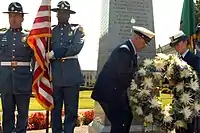 Coast Guard officers, attended by a guard of honor of the Washington State Patrol, lay a wreath at the Medal of Honor memorial in Olympia, Washington on Douglas Munro Memorial Day in 2009.
Coast Guard officers, attended by a guard of honor of the Washington State Patrol, lay a wreath at the Medal of Honor memorial in Olympia, Washington on Douglas Munro Memorial Day in 2009.- Video of scenes from the annual observances memorializing the death of Douglas Munro on September 27, 2016, in Cle Elum, Washington
 Catherine Ebert-Gray, United States Ambassador to the Solomon Islands, is pictured laying a wreath at the Munro memorial at the Point Cruz Yacht Club in 2017.
Catherine Ebert-Gray, United States Ambassador to the Solomon Islands, is pictured laying a wreath at the Munro memorial at the Point Cruz Yacht Club in 2017.
Cooley flagpole at the Douglas Munro Burial Site
For several decades, Munro's boyhood friend Mike Cooley raised and lowered the United States flag at Munro's gravesite, daily walking three miles from his home to the cemetery. According to Cooley's daughter, for over 30 years he never missed a day, even when he was ill with pneumonia.[45] Upon his death in 1999, a lighted flagpole dedicated to Cooley was installed to allow the U.S. colors to be displayed continuously at Munro's grave without the need to be lowered at dusk.[5]: 5 [46][lower-alpha 5] Cooley was cremated and his ashes interred at the Douglas Munro Burial Site with the remains of the Munro family.[48]
Since the dedication of the new flagpole, an annual military ceremony has been held at the gravesite on the anniversary of Munro's death.[6]: 141 The 75th anniversary ceremony, held in 2017, was attended by Commandant of the Coast Guard Admiral Paul Zukunft.[49]
Other
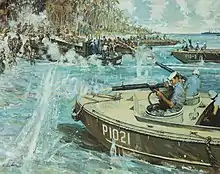
In 1989 the Coast Guard commissioned the painting Douglas A. Munro Covers the Withdrawal of the 7th Marines at Guadalcanal from Bernard D'Andrea.[50]
The Veterans of Foreign Wars post in Cle Elum is named the Douglas Munro-Robert H. Brooks VFW Post 1373, and the Anacostia chapter of the Surface Navy Association is officially named the Douglas Munro Chapter.[51][52] The Douglas A. Munro Award, established in 1971 and sponsored by the Navy League of the United States, is annually presented to an enlisted Coast Guardsman "who has demonstrated outstanding leadership and professional competence to the extent of their rank and rate".[34] The "Douglas Munro March", composed by Lewis J. Buckley, was debuted by the United States Coast Guard Band on September 26, 1982, at Constitution Hall in Washington, D.C.[6]: 144 In 2014, the Coast Guard Foundation established the Douglas Munro Scholarship Fund. University scholarships from the fund are awarded to the children of U.S. Coast Guard personnel.[53]
Several members of Munro's extended family have been named Douglas as a familial tribute to Munro.[32] The former Washington Secretary of State, Ralph Munro, who is not related to Douglas Munro, has said he frequently visits Munro's grave for personal reflection.[54]
Ratings
| Seaman 3rd Class | Seaman 2nd Class | Seaman 1st Class | Signalman 3rd Class | Signalman 2nd Class | Signalman 1st Class |
|---|---|---|---|---|---|
| E-1 | E-2 | E-3 | E-4 | E-5 | E-6 |
 |
 |
 |
 |
 |
 |
| September 18, 1939[1] | December 19, 1939[1] | January 26, 1940[1] | September 21, 1940[1] | May 1, 1941[1] | November 1, 1941[1] |
Decorations
As well as the Medal of Honor, Munro was awarded the Purple Heart, the Coast Guard Good Conduct Medal, the American Defense Service Medal, the American Campaign Medal, the Asiatic-Pacific Campaign Medal (with one battle star), and the World War II Victory Medal.[1][10]
| Medal of Honor | |||||
| Purple Heart Medal | Coast Guard Good Conduct Medal | American Defense Service Medal | |||
| American Campaign Medal | Asiatic-Pacific Campaign Medal with one battle star | World War II Victory Medal | |||
See also
Notes
- ↑ Marcus Hanna of the United States Lighthouse Board received the Medal of Honor for bravery in action at the siege of Port Hudson while serving with a Massachusetts Militia regiment in the Union Army.[2]
- ↑ During World War II, James Munro served as a captain in the Washington State Guard.[5]: 2 [6]: 6 [7] The Washington State Guard was a home guard raised by Washington due to what historian Barry Stentiford has described as its "insecurities over its exposed location" and a concern by Governor of Washington Clarence D. Martin that the state would be unable to defend itself from invasion while the Washington National Guard was mustered into federal service.[8]: 143–47
- ↑ Edith Fairey's father, William Joseph Thrower Fairey, served in the British Army's 15th Lancashire Rifles. Her brother, Francis Fairey, was a military chaplain in World War I and was later commanding officer of the Irish Fusiliers of Canada.[6]: 122 [9] From 1953 to 1957 Francis Fairey sat in the House of Commons of Canada representing Victoria, British Columbia, as a member of the Liberal Party.[7][6]: 122 He would also serve as deputy minister of education in the British Columbia provincial government.[6]: 122 [7][9] Following the death of her son, then 48-year-old Edith Munro joined the Coast Guard Women's Reserve (SPARS).[5]: 5 [6]: 140 She was trained at the U.S. Coast Guard Academy and commissioned lieutenant junior grade on May 27, 1943, eventually commanding the Coast Guard women's barracks in Seattle.[5]: 5 [10] Her commissioning oath was administered by Rear Admiral Lloyd Chalker, Vice Commandant of the United States Coast Guard.[11]
- ↑ The term "gold dust twins" is a sobriquet generally meaning "a pair of inseparable and indefatigable workers". It references the mascots of Fairbank's Gold Dust Washing Powder.[15]
- ↑ The United States Flag Code permits a flag to be flown after sunset "if properly illuminated during the hours of darkness".[47]
References
- 1 2 3 4 5 6 7 8 "Department of the Treasury Form 9546: Douglas Munro Official Service Record" (PDF). defense.gov. U.S. Department of Defense. Archived from the original on February 18, 2019. Retrieved February 17, 2019.
- ↑ "The Long Blue Line: Hanna – the service's forgotten Medal of Honor hero". Coast Guard Compass. United States Coast Guard. Retrieved March 21, 2019.
- ↑ U.S. Coast Guard Historian's Office "The Gold Dust Twins"
- ↑ "CGA Campus Map".
- 1 2 3 4 5 6 7 8 9 10 11 12 13 14 Quann, C. James (Fall 2000). "A World War II Hero from Cle Elum" (PDF). Columbia: The Magazine of Northwest History. 14 (3). ISSN 0892-3094. Archived from the original (PDF) on March 28, 2016. Retrieved February 16, 2019.
- 1 2 3 4 5 6 7 8 9 10 11 12 13 14 15 16 17 18 19 20 21 22 23 24 25 26 27 28 Williams, Gary (2014). Guardian of Guadalcanal. Lakota Press. ISBN 978-0984835140.
- 1 2 3 "Parents Receive their Son's Congressional Medal" (PDF). Milwaukee Magazine. November 1943. ISSN 0741-1243. Archived (PDF) from the original on February 19, 2019. Retrieved February 18, 2019.
- ↑ Stentiford, Barry (2002). The American Home Guard: The State Militia in the Twentieth Century. Texas A&M University Press. ISBN 1585441813.
- 1 2 "Francis Thrower Fairey". parl.ca. House of Commons of Canada. Archived from the original on August 14, 2018. Retrieved February 17, 2019.
- 1 2 3 4 5 Meyers, Donald (April 9, 2017). "It Happened Here: South Cle Elum Man Became First Coast Guardsman to Win Medal of Honor". Yakima Herald. ISSN 2158-4745. Archived from the original on February 18, 2019. Retrieved February 16, 2019.
- 1 2 "Dead Son a Coast Guard Hero, Mother to Serve with SPARS". Democrat & Chronicle. newspapers.com. Associated Press. May 28, 1943. p. 4. ISSN 1088-5153. Archived from the original on February 21, 2019. Retrieved February 20, 2019.(subscription required)
- ↑ Berkower, Simone (January 28, 2008). "Cheerleading of the '20s: Epitome of Masculinity". Yale News. ISSN 2376-1024. Retrieved March 24, 2019.
- 1 2 3 Sherbs, Diana. "Coast Guard Heroes: Cmdr. Ray Evans". coastguard.dodlive.mil. United States Coast Guard. Archived from the original on October 26, 2015. Retrieved February 16, 2019.
- ↑ "The Gold Dust Twins" (PDF). defense.gov. U.S. Coast Guard Historian's Office. Archived (PDF) from the original on February 19, 2019. Retrieved February 18, 2019.
- ↑ "gold dust twins plural noun". merriam-webster.com. Merriam-Webster. Archived from the original on November 5, 2011. Retrieved February 18, 2019.
- ↑ Miller, Edward (2007). War Plan Orange: The U.S. Strategy to Defeat Japan, 1897–1945. Naval Institute Press. ISBN 978-1591145004.
- ↑ "The Coast Guard During World War II". nps.gov. National Park Service. Archived from the original on February 18, 2019. Retrieved February 17, 2019.
- ↑ "The United States Declares War on Japan". history.com. History Channel. Archived from the original on February 12, 2019. Retrieved February 18, 2019.
- 1 2 Bunch, James (1994). Coast Guard Combat Veterans: Semper Paratus. Turner Publishing Company. ISBN 1563111047.
- ↑ Thiesen, William. "Naval Operating Base "Cactus" and Coast Guard Operations in the Battle for Guadalcanal" (PDF). defense.gov. U.S. Department of Defense. Retrieved March 4, 2019.
- ↑ Thiesen, William (June 2017). "Naval Operating Base "Cactus" and Coast Guard Operations in the Battle for Guadalcanal" (PDF). Quarterdeck Log. Coast Guard Combat Veterans Association. 26 (3): 26.
At 2:30 pm on D+1, Coast Guard Lieutenant Commander Dwight Dexter came ashore from the Liggett with thirty Coast Guardsmen to establish Naval Operating Base (NOB) 'Cactus' (Cactus being the code name for Guadalcanal), or NOB Cactus ... This would become the first and only known case of a Naval Operating Base manned and run primarily by Coast Guard personnel.
- ↑ Thiesen, William H. "The Long Blue Line: The 'Gold Dust Twins' and the battle of Guadalcanal (Part 1)". Coast Guard Compass. U.S. Coast Guard. Retrieved March 26, 2019.
- 1 2 Hurlbut, James (March 15, 1943). "Death of Douglas Munro" (PDF). Letter to James Munro. Retrieved March 24, 2019.
- 1 2 3 4 5 Thiessen, William. "The Long Blue Line: The "Gold Dust Twins" and the battle of Guadalcanal (Part 2)". Coast Guard Compass. United States Coast Guard. Archived from the original on March 25, 2019. Retrieved March 25, 2019.
- ↑ "To the Pacific". destroyerhistory.org. Destroyer History. Archived from the original on February 19, 2019. Retrieved February 18, 2019.
- ↑ Shaw, Henry. "First Offensive: The Marine Campaign for Guadalcanal". nps.gov. National Park Service. Retrieved June 28, 2019.
- ↑ Burke, Matthew M. (February 20, 2019). "Nonprofit in Dispute Over Marine's Medal of Honor Agrees in Principle to Hometown Display". Stars and Stripes. ISSN 0894-8542. Retrieved March 13, 2019.
- ↑ "Coast Guard Honors Service's Only Medal of Honor Recipient". Coast Guard News. Retrieved September 27, 2017.
- ↑ Appendix B: Inventory. Wenatchee, Washington: Kittitas County Development Services. 2013. p. 146.
- 1 2 Cipriano, Ralph (September 24, 1989). "Life-Size Artwork Honors a Sailor Who Was Larger Than Life". The Philadelphia Inquirer. ISSN 0885-6613. Archived from the original on February 21, 2019. Retrieved February 20, 2019.(subscription required)
- ↑ Lagan, Christopher. "Honoring the Munro Family Legacy". coastguard.dodlive.mil. United States Coast Guard. Archived from the original on February 20, 2019. Retrieved February 18, 2019.
- 1 2 Diamond, Christopher (April 3, 2017). "Coast Guard Cutter Munro Commissioned in Honor of WWII Hero". Navy Times. ISSN 0028-1697. Archived from the original on February 19, 2019. Retrieved February 16, 2019.
- ↑ "Coast Guard Honors Cle Elum Native With Newest Ship". KING-TV. April 1, 2017. Retrieved March 24, 2019.
- 1 2 Lane, Greg (September 2018). "The Coast Guard's Medal of Honor Recipient". usni.org. United States Naval Institute. Archived from the original on February 17, 2019. Retrieved February 16, 2019.
- ↑ Smith, Zach (November 20, 2013). "Coast Guard Names D.C. Headquarters After Douglas Munro". Daily Record. ISSN 0744-7329. Archived from the original on February 19, 2019. Retrieved February 16, 2019.
- ↑ "H.R. 2611 – A bill to designate the United States Coast Guard Headquarters the "Douglas A. Munro Coast Guard Headquarters Building"" (PDF). republicans-transportation.house.gov. U.S. House of Representatives. Archived from the original on February 18, 2019. Retrieved February 17, 2019.
- ↑ McElhenney, John (April 25, 1999). "New Monument Honors Fallen Hero". Hartford Courant. newspapers.com. Associated Press. p. 23. ISSN 1047-4153. Archived from the original on February 21, 2019. Retrieved February 20, 2019.(subscription required)
- ↑ Rajtar, Steve (2015). War Monuments, Museums and Library Collections of 20th Century Conflicts: A Directory of United States Sites. McFarland. ISBN 978-1476612379.
- ↑ Young, Stephanie. "In Defense of His Country". coastguard.dodlive.mil. Coast Guard Compass. Archived from the original on February 17, 2019. Retrieved February 16, 2019.
- ↑ Nye, David (July 11, 2015). "This Man Is the Only US Coast Guard Member to Ever Win a Medal of Honor". Business Insider. Archived from the original on July 16, 2015. Retrieved February 16, 2019.
- ↑ "Douglas Munro Memorial". museumoffloridahistory.com. Museum of Florida History. Archived from the original on February 17, 2019. Retrieved February 17, 2019.
- ↑ Mink, Michael (May 25, 2017). "Douglas Munro's Devotion To Duty Helped Save Hundreds Of Marines". Investor's Business Daily. ISSN 1061-2890. Archived from the original on February 18, 2019. Retrieved February 18, 2019.
- ↑ Kershner, Jim. "South Cle Elum – Thumbnail History". HistoryLink. HistoryInk. Retrieved July 23, 2019.
- ↑ "Coast Guard Medal of Honor Recipient Remembered". Coast Guard News. July 25, 2009. Archived from the original on July 28, 2009. Retrieved February 15, 2019.
- ↑ "If You Build It, They Will Come" (PDF). Coast Guard Retiree Council Northwest Newsletter. September 29, 1999. Retrieved July 23, 2019.
- ↑ Malkin, Michelle (September 26, 2002). "Coast Guard Lights a Hero's Flag". Star-Gazette. newspapers.com. Creators Syndicate. p. 15A. ISSN 0744-7094. Archived from the original on February 21, 2019. Retrieved February 20, 2019.(subscription required)
- ↑ Trex, Ethan (March 30, 2011). "Rules on Flying the American Flag". CNN. Archived from the original on November 21, 2011. Retrieved February 16, 2019.
- ↑ Sheehan, Douglas (Autumn 2010). "Remarks at the Ceremony Honoring Douglas Munro" (PDF). The Cutter. Foundation for Coast Guard History. Retrieved July 23, 2019.
- ↑ Carstens, Matt (September 28, 2017). "Munro's Legacy Leaves Lasting Effect on Generations of Coast Guard Members". Daily Record. ISSN 0744-7329. Archived from the original on September 29, 2017. Retrieved February 16, 2019.
- ↑ "Medal Monday: Honoring Douglas Munro and the U.S. Coast Guard". mohmuseum.org. National Medal of Honor Museum. July 30, 2018. Retrieved July 30, 2018.
- ↑ Swift, Mary (February 26, 2014). "Cle Elum to Host Traveling Vietnam Wall". Daily Record. ISSN 0744-7329. Archived from the original on February 19, 2019. Retrieved February 18, 2019.
- ↑ "Chapters". navysna.org. Surface Navy Association. Archived from the original on September 16, 2017. Retrieved February 16, 2019.
- ↑ "New Scholarship for Coasties' Kids". Yachting Magazine. March 3, 2014. Archived from the original on February 19, 2019. Retrieved February 16, 2019.
- ↑ "My Favorite Places". TVW. TV Washington. Archived from the original on November 14, 2021. Retrieved March 25, 2019.
External links
- Denfield, Duane (January 12, 2015). "Douglas Albert Munro receives the Medal of Honor posthumously on May 24, 1943". HistoryLink. Retrieved February 18, 2019.